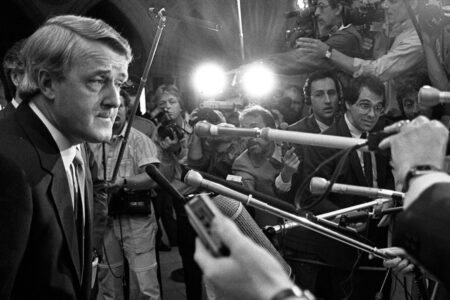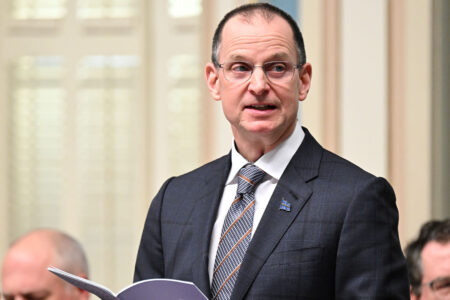
On March 23, I arrived at the Metro Toronto Convention Centre for my first ever NDP convention. It was the third party convention I attended in a span of 10 months, following the Conservative policy convention in June 2011 and the Liberal policy convention of this past January, both held at the new Convention Centre in Ottawa. I had no idea what to expect, except for the likelihood that the new leader would be Thomas Mulcair.
For only the second time in Canadian history, a leader would be selected using the one-member, one-vote system. The Conservatives selected Stephen Harper as their leader using this system in 2004. This system allowed every one of the over 130,000 members of the party to vote from the comfort of their home, either in advance by mail or online, or online in real time. It’s quite different from a delegated convention, where one must be in the room to vote and have been selected by one’s riding association.
As it turned out, this system in no way matched the delegated system when it comes to excitement and action on the convention floor. The NDP did their best to create excitement with live voting on the floor and online. But in the event, this was only about 10 percent of the turnout. All the other preferential votes were already cast in the advance poll. The accounting firm counting the votes obviously knew the outcome before Canadians did.
The NDP did their best to create excitement with live voting on the floor and online. But in the event, this was only about 10 percent of the turnout. All the other preferential votes were already cast in the advance poll. The accounting firm counting the votes obviously knew the outcome before Canadians did.
Entering the convention site at the concrete South Hall of the Convention Centre, we were met with people handing out brochures from various left-leaning organizations and others handing out leadership camps’ swag. Each camp had chosen a different colour so as to stand out on the floor. The leadership convention took up two floors of the massive South Hall, which is at least a 10-minute walk from the entrance on Toronto’s Front Street. On the upper level were all of the candidates’ offices and a group of exhibitors that more resembled a craft sale than what one’s used to seeing at a political convention. There were people selling buttons and things you’d expect to see at an NDP convention. Also among the exhibitors was the nonpartisan Broadbent Institute. What was really striking was that there was no attempt by the party to make money. There was nowhere to make a donation and no booth set up that was selling NDP merchandise.
One would assume that the cost of renting such a convention hall for several days would be quite high but this was not demonstrated in the cost of attending. The maximum cost for a delegate was $349, which is low in comparison to most other parties.
The cost of attending as an observer was $1,000, an odd figure considering the maximum annual donation to a political party under the Federal Accountability Act is $1,200, and that someone willing to pay $1,000 to be there wouldn’t likely change their mind over $200. Consider: 60 observers would be a difference of $60,000, which would cover the salary of a staffer at NDP headquarters for a year. We don’t yet know this year’s first quarter of fundraising numbers for the NDP and whether they made money from the convention. One thing we do know is that they have over 130,000 NDP members at $10 each, which would provide them with $1.3 million per year, were they to retain these members. This is something to be considered as the public campaign subsidy of political parties is phased out before the next election.
As we made our way to the lower level, the number of supporters increased dramatically and there were cheering and chanting competitions between the camps. There was one concession stand and many voting stations outside the main hall. In total they had almost 200 laptops that they had rented for the voting process. Upon entering the main room we were treated to great visuals with large screens and a spectacular halo on the ceiling. The stage was set up with a runway coming out from the back. The convention organizers did an incredible job on this set-up.
The visuals made for outstanding television, which compensated for the coldness of the hall, a huge underground bunker.
The main events for Day One, the Friday, were the candidates’ presentations and a tribute to Jack Layton. The Layton tribute would prove to be much the more memorable of the two. Each candidate was given 20 minutes to do with whatever they chose. To begin the speeches, Nathan Cullen sat on a stool and chatted for his 20 minutes. He was at once very laid back and quite passionate. All of the other candidates’ presentations were much more complex and involved other elements — other people speaking, videos, a rap show and drummers. Had Cullen drawn a slot in the middle as opposed to the beginning, the contrast would have likely been more effective.
Paul Dewar’s show started off a little differently, as he had Charlie Angus, the MP from Northern Ontario, and an unheard-of rapper named Obi do a song that Angus had written as a tribute to Layton. The idea of the tribute was lovely but what it had to do with Dewar’s candidacy remains a mystery. Little did the audience know that this wouldn’t be the low point. No one knows who was responsible for Mulcair’s or Nash’s presentation, but neither of them was left with enough time to finish what they had to say. Mulcair wasted 5 of his 20 minutes making an entrance with a team of drummers and then had to race through his speech. Nash had so many other people speaking that the music cut her off, like an Oscar winner’s acceptance speech running too long. The same thing happened to Stéphane Dion at the Liberal convention in 2006, with one difference — he won. Nash finished fourth.
Once the candidates’ presentations were over, the first-ballot live voting began, with a break before the evening’s schedule got underway. The tribute to Layton was both touching and true, as well as beautifully produced, including an outstanding video and several speeches. Exceptionally, the principal presenters, other than Olivia Chow and Layton’s children, were the two senior members of his campaign team and his staff in the Opposition Leader’s Office — chief of staff Anne McGrath and principal secretary Brad Lavigne. This was a tribute not only to their role in getting him from fourth place to Stornoway, but the closeness of the remarkable Layton team. It was a striking and professional contrast to the amateur hour of the candidates’ presentations.
Layton’s son, Mike, thanked the party for continuing his father’s legacy, while Layton’s daughter, Sarah, said he wanted his granddaughter, Beatrice, to grow up in a world that was optimistic.
Olivia Chow’s speech was by far the best of the entire convention, and learning she had written it herself, one was even more impressed. The Layton family didn’t leave many dry eyes in the room.
That was the end of the official program for the evening but the night was full of festivities in the form of hospitality suites, a tried and true highlight of every convention, in every party. This is where one roams from suite to suite, consuming free beer and wine. But not all of it was free. Mulcair had his party in a small room off the lobby of the Intercontinental Hotel, adjacent to the Convention Centre. This party, in what may have been a first for a convention hospitality suite, had a cash bar, charging $11 for a glass of wine. Given the outcome the next evening, the importance of free booze at conventions may be somewhat overstated.
On the Friday afternoon, some of us saw polling results from the Brian Topp camp, by pollster John Laschinger of Northstar Research. They had Martin Singh and Niki Ashton at the bottom, and Dewar in fifth place. Everything else in the numbers was to be expected, with Mulcair in first and Topp in second. As the first-ballot results were announced Saturday morning, Laschinger’s numbers were bang on. The most interesting number was the voter turnout. With over 130,000 eligible voters, it turned out that just over 50 percent of NDP members had voted and that there were roughly 7,000 people who had voted online.
In a roundabout way the people from Pricewaterhouse Coopers could have likely announced the winner then and there. And they probably knew the results.
We all knew that the CBC was only going to cover the convention up until Hockey Night in Canada, so the clock was ticking for them to get through the next few rounds of voting. Unfortunately, that didn’t happen. It turned out that there were serious issues with the online voting system that led to lengthy delays on every ballot. Second-round voting opened shortly after the first-ballot results were announced at 10 o’clock on Saturday morning in Toronto. This was very early on the West Coast and clearly put live voters there in a bad position, especially when it’s considered about one-third of the membership base was in BC.
And then there were the technical problems. Every national party always boasts of having the latest technology at their convention, and there are always technological screw-ups. The NDP convention was no exception. Far from getting off the air before the east coast version of Hockey Night in Canada, they were fortunate to be finished just before the west coast game at 10 o’clock Eastern time, 7 o’clock in Vancouver.
Once the second-ballot result was finally announced, Nash was out and we were left with a threeman race. Like others who had been eliminated, Nash refused to endorse anyone. While there were few votes in play, one would still have thought that the showing of support to another camp would be symbolic. Clearly, Nash remained neutral as a way to hedge her bets, of regaining the coveted finance critic role, whoever won, particularly if it were Mulcair. That some of her union supporters, notably the Canadian Union of Public Employees, went to Mulcair rather than Topp, was a defining moment of crass opportunism.
After more delays and an alleged cyber-attack of the voting system, we were finally provided with the results of the third ballot, which had Mulcair moving inevitably closer to victory. Indeed, he had widened his lead on every ballot. Cullen was eliminated and we were left with a two-man race that Mulcair was sure to win.
Mulcair’s victory speech did nothing to reenergize the room. I bet he wished he hadn’t turned down the offer of assistance from the NDP speech-writing team. Most of us were headed for the doors, and dinner or drinks, the moment the speech was over.
Photo: Shutterstock






